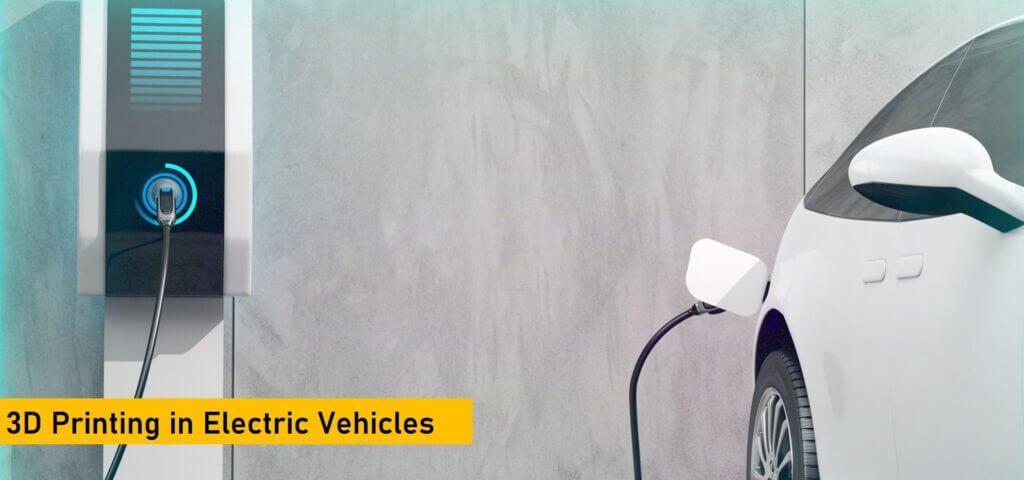The steady growth of the worldwide electric vehicle market depicts two important facts – a surge in the demand for electric vehicles and the option to choose from a wide range of electric vehicle models. The surge in demand encourages manufacturers to design and build new models of vehicles powered by electric vehicles.
But manufacturers have to overcome several challenges to design and develop electronic vehicles. Manufacturers overcome common electric vehicle designing and development challenges by leveraging cutting-edge technologies. Like battery technologies, additive manufacturing or 3D printing technologies help manufacturers overcome some of these key challenges.
Leading electronic vehicle manufacturers prefer 3D printing technologies to traditional or subtractive manufacturing methods to increase time to market and reduce production costs. Also, large automotive companies invest in R&D to integrate 3D printing into the EV manufacturing process seamlessly.
Likewise, many manufacturers focus on overcoming the challenges associated with producing electronic vehicles using 3D printing technologies instead of subtractive manufacturing technologies. Hence, we can discuss the potential impact of 3D printing on the electronic vehicle industry based on innovative use cases and research projects.
3D Printing for Electric Vehicles: The Impact of 3D Printing on Electronic Vehicle Manufacturing
Increased Speed to Market
A recent study suggests that the transition to EV is slower than expected. Many automotive companies manufacture electric cars along with conventional cars. Hence, they look for options to produce a lower number of EVs according to the current demands. No manufacturer can reduce overheads without producing a large number of EVs using conventional manufacturing methods.
But 3D printing technologies facilitate both low-volume and on-demand production of EVs. The cost-per-unit and number of iterations do not increase despite the number of vehicles produced remaining low. The decrease in iterations helps automotive companies increase speed to market without escalating production costs.
EV Customization
In the age of product customization and personalization, automotive companies cannot increase EV sales without customizing vehicles according to customer needs. Customization is often mentioned as one of the key advantages of 3D printing.
Engineers can customize a 3D-printed EV according to the needs and preferences of individual customers simply by altering the digital 3D model. The absence of expensive machine tooling and shorter production cycles enable companies to deliver customized EVs to customers in a short amount of time.
Design Flexibility
Unlike conventional production methods, 3D printing technologies enable engineers to produce parts with complex geometries without putting in extra time and effort. They can use 3D modeling software to create complex designs and use 3D printers to convert complex designs into real parts.
Also, 3D printing creates opportunities for them to finetune complex parts by evaluating them thoroughly and fixing design flaws. At present, engineers use 3D printers to evaluate parts by creating prototypes and improve parts by implementing design changes.
Extended Battery Life
Extending battery life is one of the key challenges in EV manufacturing. Automotive companies invest in R&D to drive EV sales using superior rechargeable batteries. 3D printing, like widely used battery technologies, extends EV battery life in several ways.
Engineers can 3D-print innovative components and parts that extend battery life by reducing the weight of an EV. Also, they can produce lightweight EVs by consolidating multiple parts. At the same time, engineers also have the option to 3D-print heat exchangers and encasings that extend battery life by regulating temperatures.
Digital Warehousing
In addition to escalating operational costs, conventional warehouses extend the production cycle of EVs. But no automotive company can produce EVs using conventional manufacturing techniques without focusing on the storage and transportation of components and spare parts.
3D printing technologies help automotive companies overcome this challenge by replacing physical warehouses with digital warehouses. Engineers can produce 3D-printed parts in days based on digital 3D models. An automotive company can 3D-print parts on demand without investing in inventory and warehousing.
Further, it can facilitate remote or localized production of spare parts by making engineers access the digital 3D model over the internet. Hence, 3D printing makes the EV supply chain agile along with reducing lead time and overheads.
Material Options
Tech bloggers often cite limited material options as one of the major shortcomings of 3D printing for mass production. But manufacturers these days have the option to choose from a wide range of classic and new-age 3D printing materials.
They can choose from many forms of polymer while creating lightweight components using plastic 3D printing technologies. Likewise, they can improve the EV’s performance, strength, and safety by producing parts using metal 3D printing technologies.
Leading automotive companies these days produce parts by creating custom 3D printing materials with the desired mechanical properties. The 3D printing service providers create opportunities for EV manufacturers to experiment with a wide range of materials on demand.
The emergence of 3D-Printed EV Cars
In 2022, XEV – an innovative electric vehicle startup company – unveiled a 3D-printed electric car called YOYO. 3D printing technologies enable XEV to sell at around €10,000 in Italy by eliminating the need to use expensive machine tooling.
At present, buyers have the option to choose from many 3D-printed EV cars including YOYO. YOYO will encourage many electronic vehicle companies to shorten production cycles, support on-demand production, and support product customization by 3D-printing EV vehicles.
Joint Research Projects
In 2021, Hyundai Motor Corp collaborated with researchers to undertake joint research projects that transform traditional car manufacturing using Industry 4.0 technologies like 3D printing and artificial intelligence.
The researchers will find solutions to integrate 3D printing into the EV manufacturing process. In addition to customizing automotive components, the projects aim to create opportunities for buyers to personalize EV car models.
Conclusion
3D printing is one of the Industry 4.0 technologies that have been transforming the worldwide EV industry. In addition to 3D-printing EV vehicles, 3D printing technologies help manufacturers curtail lead time and production costs.
Leading automotive companies have been investing in R&D to make 3D printing an integral part of the EV manufacturing process in the near run. They will continue 3D-printing EVs to launch new EV models regularly without increasing upfront and ongoing costs.
About Aurum3D
We are amongst the major 3D printing companies in Bangalore, India. We have been providing SLS, SLA and custom FDM 3D printing services to almost all major industries including the automotive industry and electric vehicle manufacturers. Please feel free to get in touch with us for your custom needs, our 3D printing solutions experts will get back to you within one business day.

